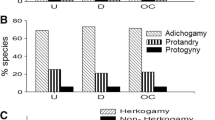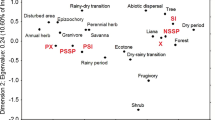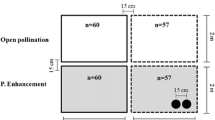Abstract
The reproductive biology of 29 herbaceous understory monocot species was studied in a tropical cloud forest of northern coastal Venezuela (Henri Pittier National Park). Of the 23 plant species, 6 (26.1%) were self-incompatible and 17 (73.9%) self-compatible, the latter consisting of 12 (52.2%) fully self-compatible and 5 (21.7%) partially self-compatible species. An analysis of sexual systems and temporal variation of sex expression showed that of 29 monocot species, 14 (48.3%) were hermaphrodite and adichogamous, 14 (48.3%) monoecious and dichogamous, and one (3.4%) dioecious. The combination of monoecy and dichogamy prevented autogamy in 11 (91.7%) of the 12 self-compatible and monoecious species; one (8.3%) was autogamous. Of all species, 24 (82.8%) were obligate outbreeders, 2 (6.9%) spontaneously autogamous, and 3 (10.3%) partially autogamous. Ovule and flower abortion were not significantly different between the different groups. Pollen-ovule ratio was significantly different between monoecious and hermaphrodite species. The number of pollen grains and ovules per flower and the pollen-ovule ratio were variable among various pollination types. The average pollen-ovule ratio was higher in beetle-, dipteran-, and wind-pollinated species than in bee-, bird-, and bat-pollinated species. The first three pollination types were restricted to monoecious species, and the second three groups were restricted to hermaphrodite species. Of 33 plant species investigated, 12 (36.4%) displayed vegetative reproduction. The reproductive features of the understory monocot species are discussed in the context of life form, devices of cross-pollination, and geological history of the tropical cloud forest.
Similar content being viewed by others
References
Anderson, G. J., Stebbins, G. L., 1984: Dioecy versus gametophytic self-incompatibility: a test. — Amer. Naturalist124: 423–428.
Arroyo, M. T., Cabrera, M., 1978: Preliminary self-incompatibility test for some tropical cloud forest species in Venezuela. — Incomp. Newsl.8: 72–76.
Bawa, K. S., 1974: Breeding systems of tree species of a lowland tropical community. — Evolution28: 85–92.
—, 1985: Reproductive biology of tropical lowland rain forest trees. I. Sexual systems and incompatibility mechanisms. — Amer. J. Bot.72: 331–345.
Baker, H. G., 1955: Self-compatibility and establishment after “long-distance” dispersal. — Evolution9: 347–349.
Bullock, S. H., 1985: Breeding systems in the flora of tropical deciduous forest in Mexico. — Biotropica17: 287–301.
Charnov, E. L., 1982: The theory of sex allocation. — Princeton: Princeton University Press.
Cruden, R. W., 1977: Pollen-ovule ratios: a conservative indicator of breeding systems in flowering plants. — Evolution31: 32–46.
Ewel, J. J., Madriz, A., Tosi, J. A., 1976: Zonas de vida de Venezuela. Ministerio de Agricultura y Cria, Fondo Nacional de Investigaciones Agropecuarias. — Caracas: Editorial Sucre.
Faegri, K., van der Pijl, L., 1971: The principles of pollination ecology. 2nd edn. — London: Pergamon Press.
Feinsinger, P., 1987: Effects of plant species on each other's pollination: is community structure influenced? — Tree2: 123–127.
Ganeshaiah, K. N., Uma Shaanker, R., 1991: Floral sex ratios in monoecious species. Why are trees more male-biased than herbs. — Curr. Sci.60: 319–321.
Haffer, J., 1982: General aspects of the refuge theory. — InPrance, G. T., (Ed.): Biological diversification in the tropics, pp. 6–24. — New York: Columbia University Press.
Huber, O., 1986: Las selvas nubladas de Rancho Grande: observaciones sobre su fisionomia, estructura y fenologia. — InHuber, O., (Ed.): La selva nublada de Rancho Grande, Parque Nacional Henri Pittier. El ambiente fisico, ecologia vegetal y anatomia vegetal, pp. 131–170. — Caracas: Editorial Arte.
Janzen, D. H., 1970: Herbivores and the number of tree species in tropical forests. — Amer. Naturalist104: 501–528.
Kress, W. J., 1983: Self-incompatibility in Central AmericanHeliconia. — Evolution37: 735–744.
Lloyd, D. G., 1980: Benefits and handicaps of sexual reproduction. — Evol. Biol.13: 69–111.
—, 1986: The avoidance of interference between the presentation of pollen and stigmas in angiosperms. I. Dichogamy. — New Zealand J. Bot.24: 135–162.
McDade, L. A., 1985: Breeding systems of Central AmericanAphelandra (Acanthaceae). — Amer. J. Bot.72: 1515–1521.
McMullen, C. K., 1987: Breeding systems of selected Galapagos Islands Angiosperms. — Amer. J. Bot.74: 1694–1721.
Opler, P. A., Bawa, K. S., 1978: Sex ratio in some tropical forest trees. — Evolution32: 812–821.
Ramirez, N., Brito, Y., 1990: Reproductive biology of a tropical palm swamp community in the Venezuelan llanos. — Amer. J. Bot.77: 1260–1271.
Ruiz, T., Arroyo, M. K., 1978: Plant reproductive ecology of a secondary deciduous tropical forest in Venezuela. — Biotropica10: 221–230.
Salisbury, E. J., 1942: The reproductive capacity of plants. — London: Bell.
Schemske, D. W., 1983: Breeding system and habitat effects on fitness components in three neotropicalCostus (Zingiberaceae). — Evolution37: 523–539.
Schoen, D. J., 1982: Male reproductive effort and breeding system in hermaphroditic plant. — Oecologia53: 255–257.
Sobrevila, C., Arroyo, M. K., 1982: Breeding systems in a montane tropical cloud forest in Venezuela. — Pl. Syst. Evol.140: 19–37.
Sokal, R. R., Rohlf, J., 1981: Biometry. — San Francisco: Freeman.
Steyermark, J. A., 1982: Relationships of some Venezuelan forest refuges with lowland tropical flora. — InPrance, G. T., (Ed.): Biological diversification in the tropics, pp. 182–220. — New York: Columbia University Press.
Sutherland, S., 1986: Floral sex ratios, fruit set, and resource allocation in plants. — Ecology67: 991–1001.
Thomas, A. G., Dale, H. M., 1974: Zonation and regulation of old pasture populations ofHieracium floribundum. — Canad. J. Bot.52: 1451–1458.
Wiens, D., 1984: Ovule survivorship, brood size, life history, breeding system, and reproductive success in plants. — Oecologia64: 47–53.
—, 1987: Reproductive success, spontaneous embryo abortion and genetic load in flowering plants. — Oecologia71: 501–509.
Willson, M. F., Burley, N., 1983: Mate choice in plants: tactics, mechanisms, and consequences. — Princeton: Princeton University Press.
Webb, C. J., Lloyd, D. G., 1986: The avoidance of interference between the presentation of pollen and stigmas in angiosperms. II. Herkogamy. — New Zealand J. Bot.24: 163–178.
Xena de Enrech, N., Ramirez, N., Sobrevila, C., 1988: Notas sobre la dinámica reproductiva de una comunidad vegetal de vega de rio. — Actes Simposi Internac. Bot. Pius Font i Quer2: 69–82.
Author information
Authors and Affiliations
Rights and permissions
About this article
Cite this article
Ramirez, N., Seres, A. Plant reproductive biology of herbaceous monocots in a Venezuelan tropical cloud forest. Pl Syst Evol 190, 129–142 (1994). https://doi.org/10.1007/BF00986189
Received:
Revised:
Accepted:
Issue Date:
DOI: https://doi.org/10.1007/BF00986189




